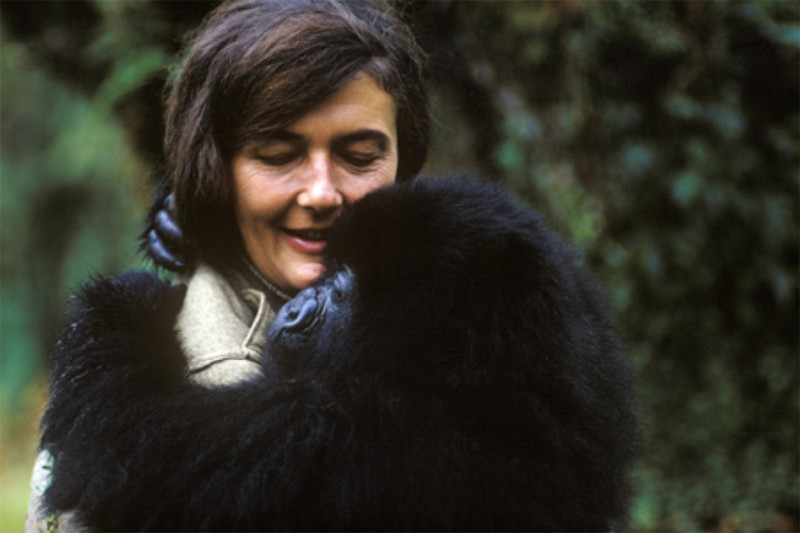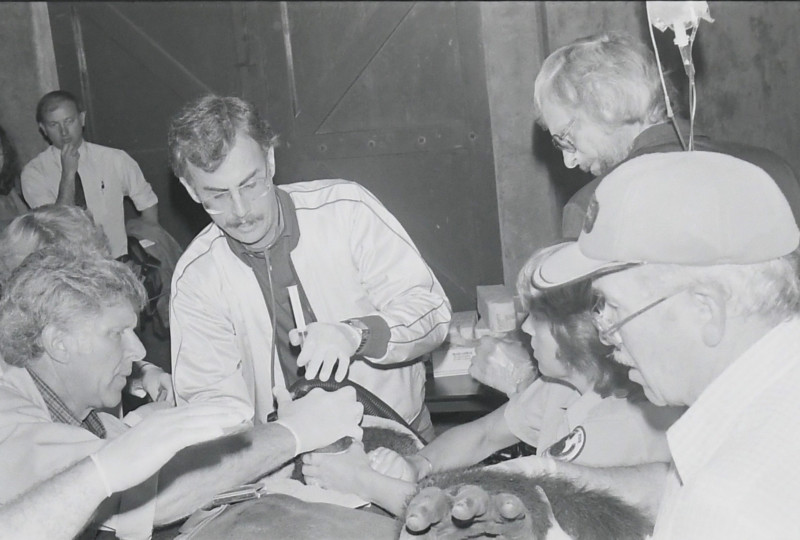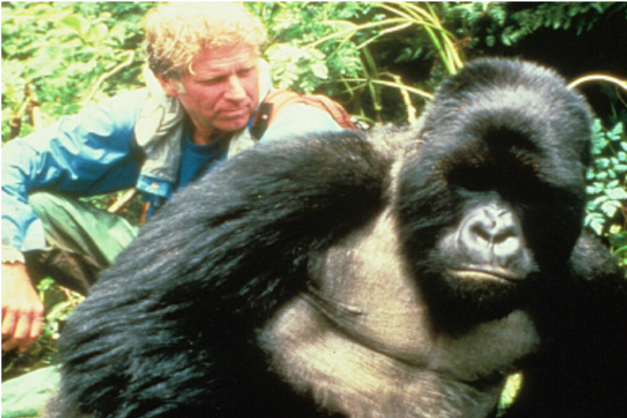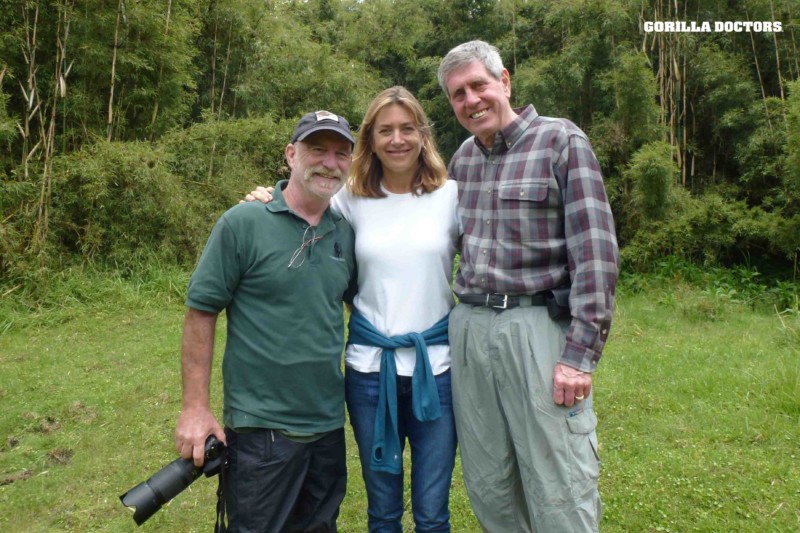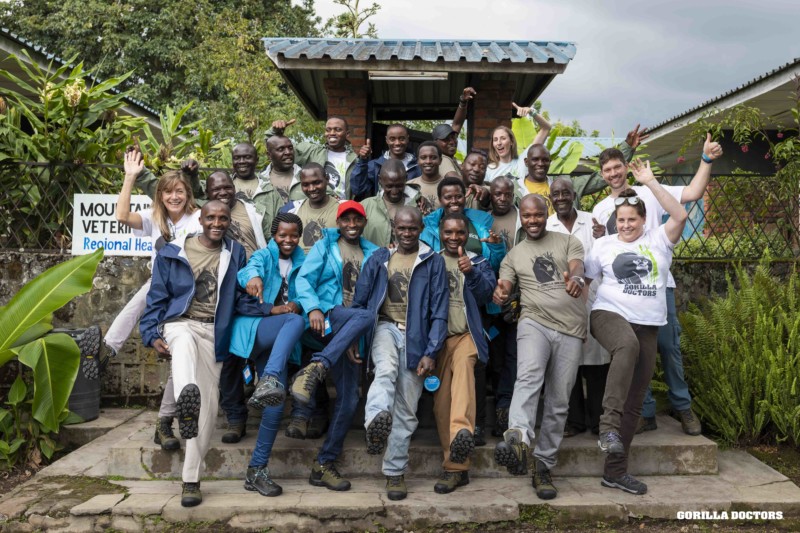Growing Up Gorilla Doctors
By Gorilla Doctors Staff on Monday, August 3rd, 2020 in Blog.“The mountain gorillas will be extinct by 2000. We need a veterinarian on site.”
According to mountain gorilla lore, Dian Fossey said this to Ruth Morris Keesling at the international symposium, ‘What We Can Learn about Humankind from Apes,’ held in California in May 1981. The genesis of Gorilla Doctors began with those six words – We need a veterinarian on site – six words, Dian’s extraordinary vision, Ruth’s tenacity, and some microscopic detective work changed the future of mountain gorilla health and conservation.
A Force of Nature and For Nature
Ruth Morris Keesling was the daughter of Mark Morris, who founded the Morris Animal Foundation (MAF) in 1948. At its inception, MAF was focused on supporting the health of domestic dogs and cats. But then Dr. Murray Fowler, the grandfather of zoo animal veterinary medicine, and a professor at UC Davis School of Veterinary Medicine, made MAF a proposition – if MAF would add wildlife to its core mission, he would donate all proceeds from his textbook on zoological medicine to MAF (interesting side note: because of Dr. Fowler, the UC Davis School of Veterinary Medicine became the first school in the U.S. to create a course in zoo and wild animal medicine).
Ruth returned from the symposium in California declaring to the MAF Board of Directors that she was funding a veterinarian for mountain gorillas in Rwanda, more than 8,000 miles from MAF’s home in Colorado. Considering this was slightly outside of MAF’s usual boundaries at the time, Ruth agreed to fund the entire endeavor with her own personal funds via the foundation.
But it would take another five years for the first veterinarian to arrive in Rwanda.
The First Gorilla Doctor
(Historical details provided by Brianne Hoppe)
During this same time, Dr. Jim Foster was charting a career for himself that would unknowingly prepare him to become the very first Gorilla Doctor. As it turns out, Dr. Foster was a pioneer of ‘firsts’: after serving as a veterinarian for the U.S. Army and working as a small animal vet, he became the first full-time veterinarian for the Woodland Park Zoo (WPZ) in Seattle, Washington.
Foster helped transform the Woodland Park Zoo into a leading organization in the conservation and the care of zoo-housed wildlife. He pushed for zoo enclosures that mimicked what he called “ecological systems” and encouraged animals to engage in more natural behaviors. As Interim Zoo Director, he helped develop the zoo’s first long-range plan, along with zoo architect David Hancocks, which called for placing the animals in large, naturalistic exhibits, resulting in one of the first-in-the-world ‘immersion’ exhibits for the zoos gorillas.
In 1984, he began discussions with Ruth and Dian about the possibility of becoming the first mountain gorilla veterinarian in Rwanda. He was preparing to travel to Rwanda in January 1986 to establish the veterinary program when, tragically, Dian was murdered in December 1985. Dr. Foster pressed ahead, and while Dian never saw the results of her vision or Dr. Foster’s pioneering work, she did know that he was coming and that hands-on veterinary care for ill and injured mountain gorillas was about to begin.
Blazing Another New Path
(Historical details provided by Dr. Linda Lowenstine)
In the fall of 1985 Dian was at another conference, sponsored by MAF, where thanks again to Dr. Fowler, she met Dr. Linda Lowenstine, a veterinary pathologist or “disease investigator” based at UC Davis who was using laboratory diagnostics of tissue samples to gain insight into the causes of animal illness. In another testament to her vision, Dian understood the importance of pathology and the critical information it could provide in the fight for mountain gorilla conservation, and so she asked Dr. Lowenstine to review tissue samples from silverback Nunkie, made famous in her book, Gorillas in the Mist, as the “grizzled lone silverback” with an “unrelenting pursuit of females…”
That same year Dr. Lowenstine joined a clinical advisory board for the MAF’s brand-new Volcanoes Veterinary Center in Rwanda. In the decades since, she has pioneered a pathology and research protocol for the gorillas that has not only helped illuminate our understanding of what makes gorillas sick, but has deeply influenced the effectiveness of Gorilla Doctors. By combining hands-on veterinary medicine with pathological diagnostics to identify causes of gorilla illness and injury at the individual and population level, Gorilla Doctors’ work is credited for half of the annual population growth rate in habituated mountain gorillas1.
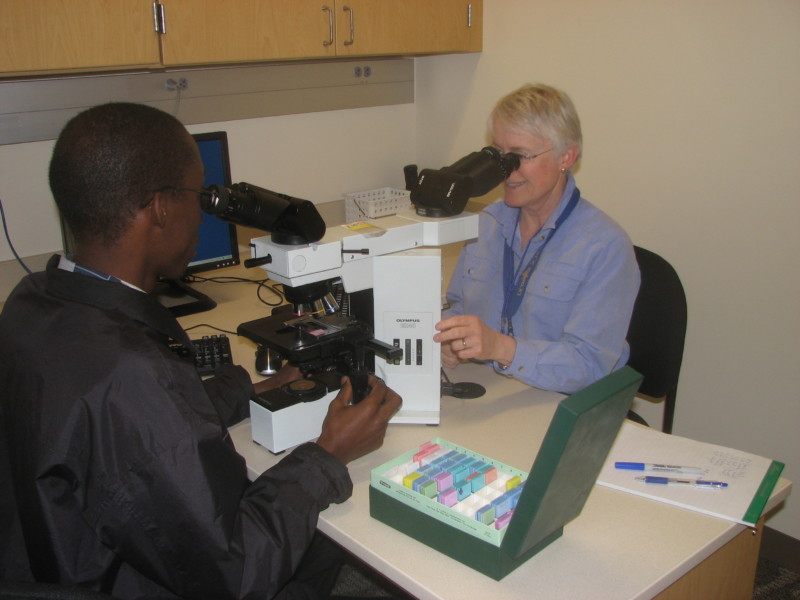
Dr. Lowenstine with then master’s student, Dr. Denis Muhangi at UC Davis School of Veterinary Medicine.
From Volcanoes Veterinary Center to Gorilla Doctors: A 34-year Odyssey
(More historical background provided by Dr. Rob Hilsenroth)
When Dr. Foster arrived in January 1986 the most recent census (in 1980) estimated the Virunga population of mountain gorillas to be only 250 individuals. He had his work cut out for him if he and the Rwanda wildlife authorities were going to help bring mountain gorillas back from the brink of extinction.
Dr. Foster stayed in Rwanda for two years, establishing the Volcanoes Veterinary Center with a few Rwandan support staff. In the beginning, he called himself a “fireman veterinarian,” rushing into the forest to treat gorilla emergencies (e.g. snares, injuries, acute illness). Over the next several years he would develop a more proactive program for monitoring and treatment that formed the basis of what is now Gorilla Doctors’ internationally-recognized leadership in great ape health and veterinary medicine.
After the initial two-year period in Rwanda, Dr. Foster continued his leadership of the overall program from the U.S., but with other veterinarians managing on-the-ground operations. Sadly, Dr. Foster passed away during a visit to Rwanda in 1997. In 1998, Morris Animal Foundation hired Dr. Mike Cranfield to run MGVP; building on Dr. Foster’s vision, Dr. Cranfield further transformed the program, expanding gorilla health monitoring and research, initiating work in Bwindi Impenetrable National Park, and training dozens of veterinarians in Rwanda, Uganda and DR Congo. Under Dr. Cranfield’s directorship and with the blessing of the Morris Animal Foundation, MGVP, Inc. was established as its own non-profit organization in 2006, with its US headquarters based at the Maryland Zoo in Baltimore.

Drs. Mike Cranfield and Jean Bosco (Noel) Noheri treat an injured mountain gorilla in Rwanda (archives) ©Gorilla Doctors
By 2009, MGVP, Inc. came full circle, partnering with the Karen C. Drayer Wildlife Health Center at UC Davis’ School of Veterinary Medicine (remember, it was Dr. Murray Fowler, from UC Davis’ Vet School who paved the way by helping to expand Morris Animal Foundation’s mission to include wildlife, and Dian attended UC Davis briefly as an undergraduate!). When MGVP, Inc. moved from the Maryland Zoo to the Wildlife Health Center, we adopted the name to Gorilla Doctors, a name in the making for nearly 35-years.
The partnership between MGVP, Inc. and the Wildlife Health Center brought in the leadership of Dr. Kirsten Gilardi, who served as the U.S. Director for 10-years. In 2019, upon Dr. Cranfield’s retirement, Dr. Gilardi became the Executive Director and Chief Veterinary Officer, filling some very big rainboots of Dr. Cranfield’s, to lead an international team of veterinarians, primatologists and support staff all inspired by her vision and dedicated to saving a species, one gorilla at a time.
Growing Up Gorilla Doctors
At the beginning of July, 39-years after Dian asked Ruth to fund a gorilla veterinarian, Gorilla Doctors launched its first social media fundraiser – Growing Up Gorilla – to support health monitoring for 56 infant mountain gorillas (0-1yr) across Rwanda, Uganda and DR Congo. Appealing to our communities on Facebook, Instagram and Twitter, our goal was to raise one month of care ($8,400). Thanks to the extraordinary generosity of more than 350 people all over the world, Growing Up Gorilla succeeded in raising more than double – enough for two full months of care!
We can only imagine what Dian would have thought about social media, but as a non-profit organization, we love the power of social media to share our work with the world. We’ve learned one thing with absolute certainty over the past few decades – Gorilla Doctors’ legacy belongs to all the people who have dedicated their talent, energy, passion, resources and commitment to helping us grow and evolve into the organization we are today.
1Robbins, et al. (2011). PLoS One 6(6): e19788
Contributors
Dr. Rob Hilsenroth, DVM – Gorilla Doctors Board Member, Executive Director American Association of Zoo Veterinarians and former Executive Director, Morris Animal Foundation, 1992 – 2004
Brianne Hoppe, Growing Up Gorilla Ambassador
Dr. Linda Lowenstine, DVM, PhD, DipACVP – Gorilla Doctors’ technical specialist in veterinary pathology and pioneering pathologist in mountain gorilla conservation; Professor (Emerita) of Veterinary Pathology, UC Davis School of Veterinary Medicine


 Donate
Donate
